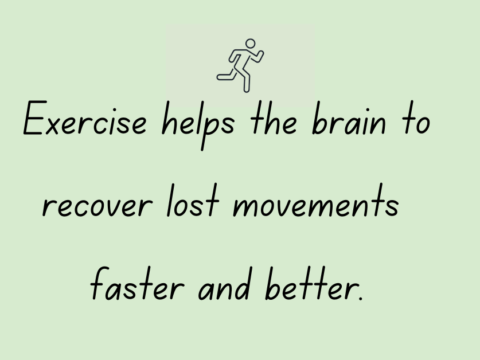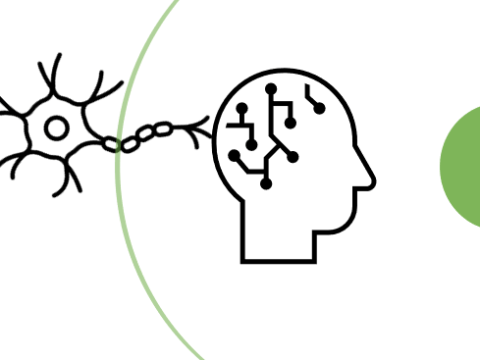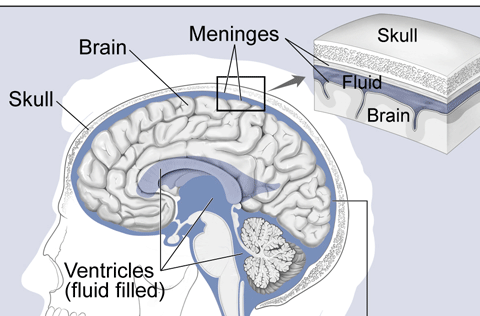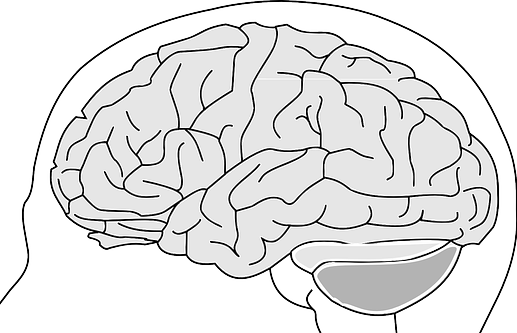
Updated on June 11, 2023
Image source: Pixabay
Let us walk on the brain’s surface.
The experience will help your daily caregiving tasks easier because this knowledge will inspire you with creative ideas. And, also will help you make useful decisions in your caregiving journey of helping your loved one to recover the lost movements and bladder control faster and better.
Moreover, it will reduce your burnout episodes and improve your relationship with the stroke survivor.
Let us begin.
Brain in a nutshell:
Our brain is an electrically charged gel-like pliable structure. It consists of two large halves, left and right hemispheres, but connected via a thick stalk deep in the middle (Figure 1). Both sides communicate via this stalk. It is called “Corpus Callosum”.

Figure 1: Two brain halves (also called hemispheres)
Regarding these two halves, stroke carers need to know one cardinal fact: The left half (another phrase is the left hemisphere) controls the right side of our bodies and the right half (another phrase is the right hemisphere) controls the left side of our bodies.
Left brain controls the right half of the body and the right brain controls the left half of the body.
Brain surface (Cerebral Cortex)
Technically, the brain surface is called the “Cerebral Cortex” – it is the outer covering, which is folded into ridges (bumps/ folds) and valleys (grooves) (see Figures 1 and 2).

Figure 2: The closely folded brain surface; bumps and grooves
This is like a closely folded bed sheet.
In the medical field, the bumps (or folds) are called gyri (its singular word is gyrus) and grooves sulci (its singular word is sulcus). These bumps (folds) and grooves provide useful landmarks to demarcate the boundaries of regions; these are called lobes. Each halve consists of four lobes: Frontal, Parietal, Temporal, and Occipital. The neurons of each lobe house distinct operational centres that perform a specific set of jobs.
However, its thickness ranges between 1 to 5.5 mm only – on average about one inch.
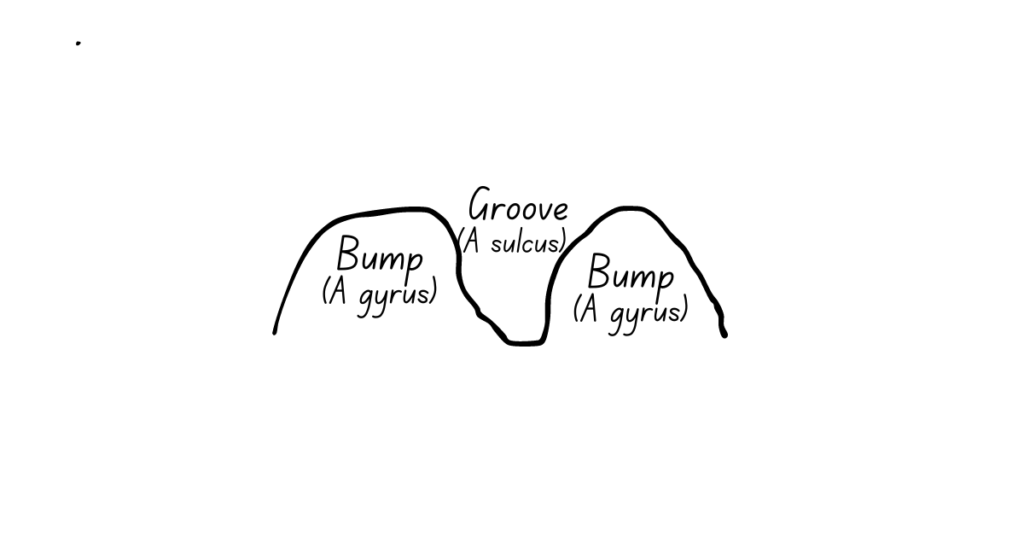
Figure 3
This naming depends on the region corresponding to its position within the skull. Interestingly, each lobe carries out a specific set of jobs. Figure 4 shows those four lobes on the left half of the brain. Similarly, we have the same mirror lobes on the right side too.

Figure 4:
Brain surface and its regions (Image source: NIH)
Surface landmarks
The grooves demarcate each lobe. Radiologists use these as landmarks to identify lobes.
The Central Groove (Central sulcus)
In Figure 5, the left Central groove (Central Sulcus) travels through the left Frontal and Parietal lobes. The red-coloured bank strip runs along in front of the Central groove while the blue-coloured strip runs parallel to the groove but behind it. Both the groove and strips disappear at the left Lateral groove (Lateral Sulcus); it separates the Frontal lobe from the Temporal lobe.
Both red and blue strips house two little virtual humanoids.
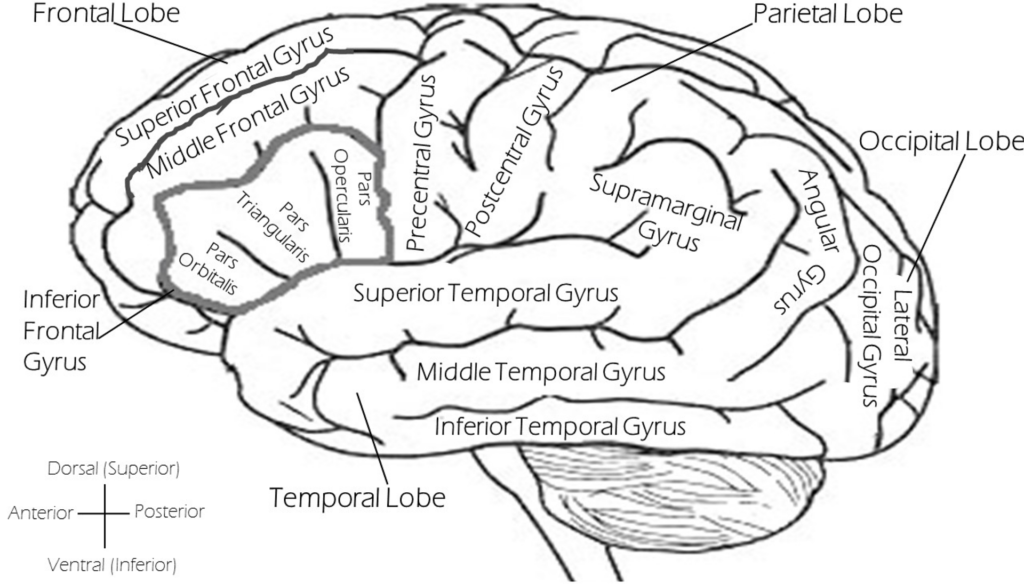
Figure 5:
Brain surface regions: Image: Pixabay
Pre-central bump (fold or gyrus):
The pre-central bump, the red-coloured strip in Figure 4, functions as the main “motor operational centre”; it commands our muscles to move the body parts from top to bottom: Mouth, fingers, arms, legs etc. When a stroke blocks the oxygen supply to the neurons in this area, the command centre loses its operational abilities resulting in either weakness or paralysis.
Post-central bump (fold or gyrus)
In contrast to the previous one, this blue-coloured bump, which lies behind the Central Groove, operates as the signal-receiving centre from the body parts. These signals include touch, temperature, and pressure; for example, if we touch a hot stove, the neurons in this area immediately receive that information through nerves via neurons. Then, after processing it, this information is sent to the red-coloured bump, which lies in front of the Central Groove for immediate action: Withdraw the hand!
However, if someone has a stroke and the neurons in the blue-coloured area are dead, we cannot process the signals we receive. Sometimes, depending on the nature of the damage, this center interprets the signals differently such as increased or decreased sensitivity to touch. This altered sensation interferes with the activities of daily living such as dressing or eating.
As a caregiver, it’s important to understand the role of the post-central gyrus so you can identify and manage changes in sensory perception and help your loved one remain comfortable and safe. Knowing about this area of the brain can also be useful in rehabilitation, as healthcare professionals and caregivers can work together to improve the processing of sensory information and support recovery.
Brain regions (lobes) in detail:
Frontal lobe
This is the largest lobe and even the largest proportionate to the body size of all animals.
Let us climb the Frontal lobe’s outer layer, the cortex, with the help of the pink arrow (Figure 5). It begins further down and ends at the red-coloured bump (Pre-central gyrus).
What do the Frontal lobe neurons do?
These neurons do things that no other animal’s neurons can do.
The frontal lobe, apart from commanding movements of body parts, carries out high-level jobs such as decision-making, problem-solving, emotional control etc.
When a stroke hits the frontal lobe neurons, those affected will not perform the above jobs. For example, a frontal lobe stroke results in weakness on one side of the body or difficulty with coordination and balance.
A stroke in this area can also result in difficulties with decision-making and impulse control, as well as changes in emotional control such as depression or irritability.
As a caregiver, understanding the potential impacts of a stroke on the frontal lobe can help you better understand the specific needs of your loved one and how best to support their recovery. For example, if the stroke survivor is experiencing changes in behavior or emotions the caregiver can work with healthcare professionals to develop methods to address those symptoms and provide a supportive and understanding environment.
This can include strategies such as
- Maintaining a structured routine,
- Avoiding overstimulation, and
- Giving opportunities for stroke survivors to engage in activities they enjoy.
Parietal lobe
As soon as I jump over the Central groove from the Frontal lobe’s edge to the other side, I land on the Parietal lobe. It lays behind the Frontal lobe. The Parietal lobe extends back until it meets the next lobe – The occipital lobe.

Figure 6:
Brain surface and its regions (Image source: NIH)
We see the upper-left side view of the left Parietal lobe in Figure 6.
The parietal lobe reads messages related to taste, touch, and temperature and controls our balance while standing and walking. That means if this area inflicts any damage, we will not be able to taste, feel touch, or temperature and will fall.
As a stroke caregiver, you can explain the signs and symptoms of a damaged parietal lobe to a stroke survivor in simple language by using the following steps:
- Explain what the parietal lobe is:
- You can tell the stroke survivor that the parietal lobe is a part of their brain that helps them feel sensations, understand space, and move the body smoothly.
- Describe the common symptoms:
- Let the survivor know that if the parietal lobe is damaged by a stroke, they may experience numbness, tingling, or decreased sensitivity on one side of their body. They may also have trouble with tasks that require coordination, like writing, drawing, or balancing.
- Use everyday examples:
- To help the survivor understand these symptoms, you can use everyday examples, such as explaining that numbness in their arm or leg might make it hard for them to put on their clothes, or that trouble with coordination might make it harder for them to walk.
- Emphasize the importance of rehabilitation:
- Explain to the survivor that rehabilitation can help them get better and improve their abilities. You can emphasize that while recovery can be slow, they can make progress over time with therapy and support.
Temporal lobe
Now, we will walk on the brain’s left side to meet another larger groove, called Lateral Fissure (Figure 7).

Figure 7:
Brain surface and its regions (Image source: NIH)
Once I cross over this fissure, I land on the Temporal lobe. The part above is the side view of the left Frontal lobe.
The Temporal lobe’s main job is to understand and interpret the language.
As a stroke caregiver, you can explain to a stroke survivor that the temporal lobe is an important part of the brain that is responsible for functions such as hearing, memory, speech, and language. The patient will show the following signs and symptoms If the stroke damages temporal lobe;
- Hearing loss:
- The person may experience difficulty hearing or understanding speech, leading to communication difficulties.
- Memory problems:
- They may experience difficulty with recalling information, retaining new information, or finding the right words.
- Speech difficulties:
- They may experience slurred speech, stuttering, or difficulty expressing themselves.
- Visual problems:
- They may experience visual hallucinations or difficulty recognizing faces or objects.
- Seizures:
- They may experience sudden seizures, uncontrolled movements or behavior changes, due to abnormal electrical activity in the brain.
Occipital Lobe
Behind the parietal and Temporal lobes, we find the Occipital lobe. This lobe spreads over the back of the brain. Without this area, we cannot see, recognize, and interpret anything although we have eyes.
As a stroke caregiver, you can explain the signs and symptoms of a damaged occipital lobe to a stroke survivor in the following way:
- Explain what the occipital lobe is:
- You can tell the stroke survivor that the occipital lobe is a part of their brain that helps with seeing and interpreting what they see.
- Describe the common symptoms:
- If the stroke damages the occipital lobe, the patient may experience vision problems such as decreased vision, double vision, blurred vision, or loss of peripheral vision.
- Use everyday examples:
- To help the survivor understand these symptoms, you can use everyday examples, such as explaining that decreased vision might make it harder for them to read or see objects clearly, or that double vision might make it difficult to watch TV or recognize people’s faces.
- Emphasize the importance of rehabilitation:
- Explain to the survivor that rehabilitation can help them get better and improve their vision. You can emphasize that while recovery can be slow, they can progress over time with therapy and support.
In our next journey, we will meet the “two little humanoids” who live on our brain surface.
Further reading
- Brain covers protect the brain
- Two little humans on the brain surface
- Neuron forest
- Neurons
- Brain’s blood supply routes
- Types of stroke
- Brain’s recovery attempts after stroke
- How stroke causes speech problems
